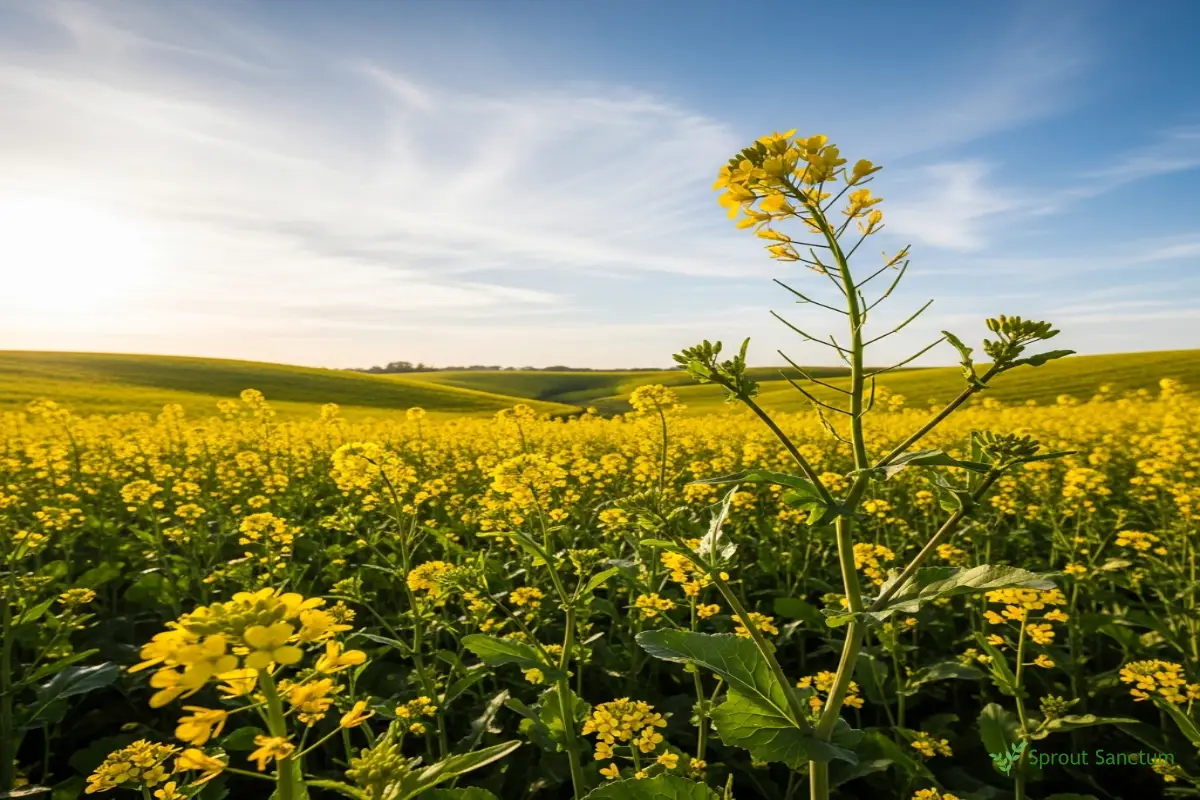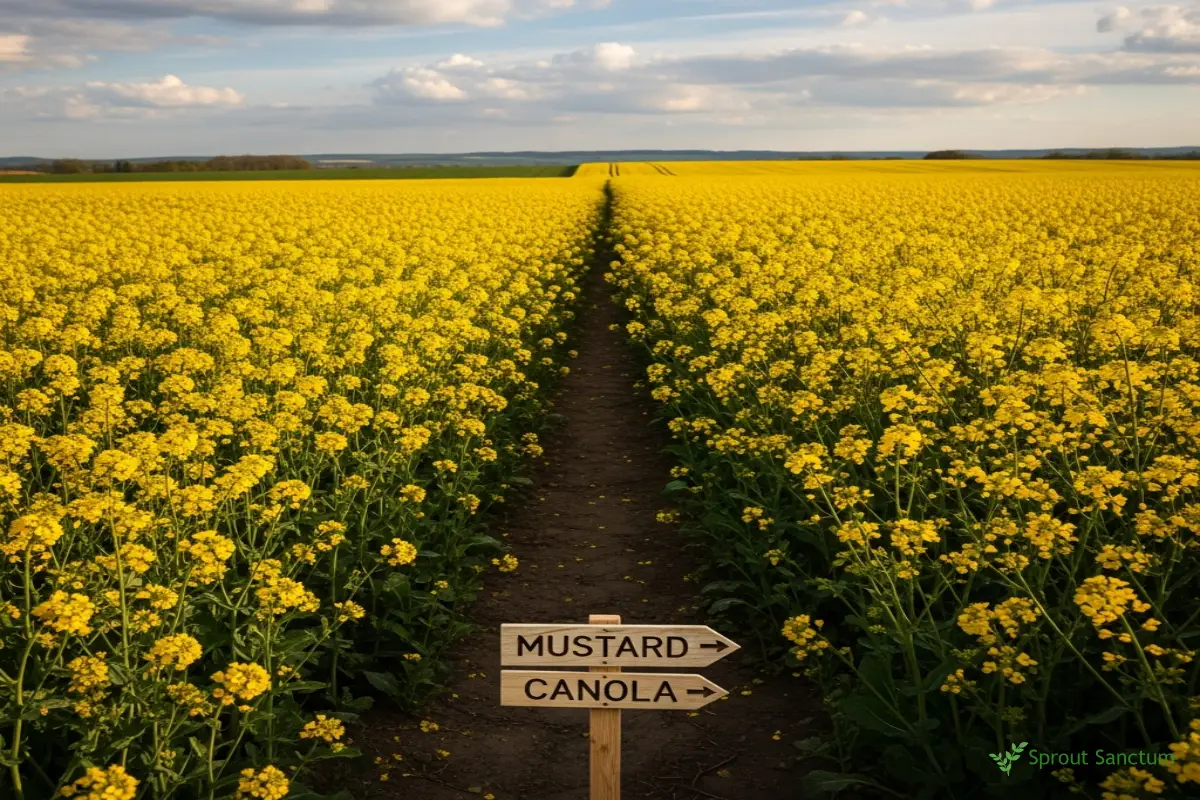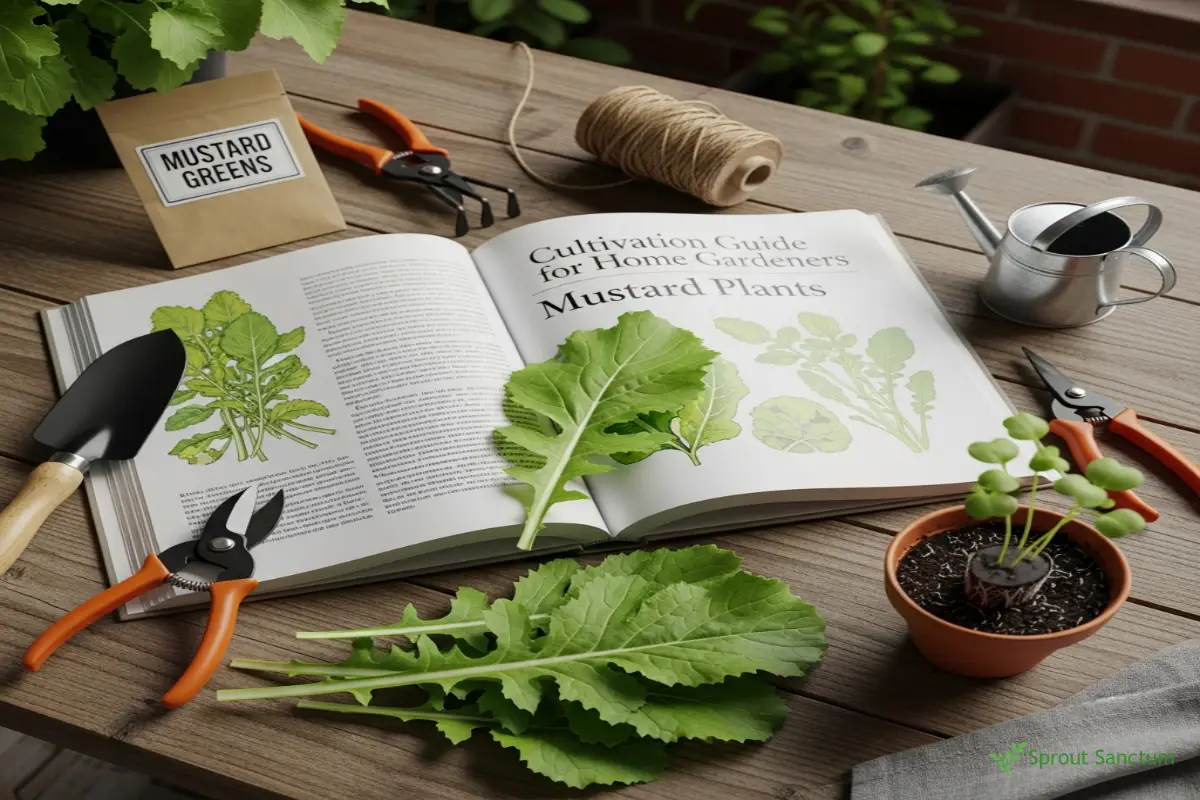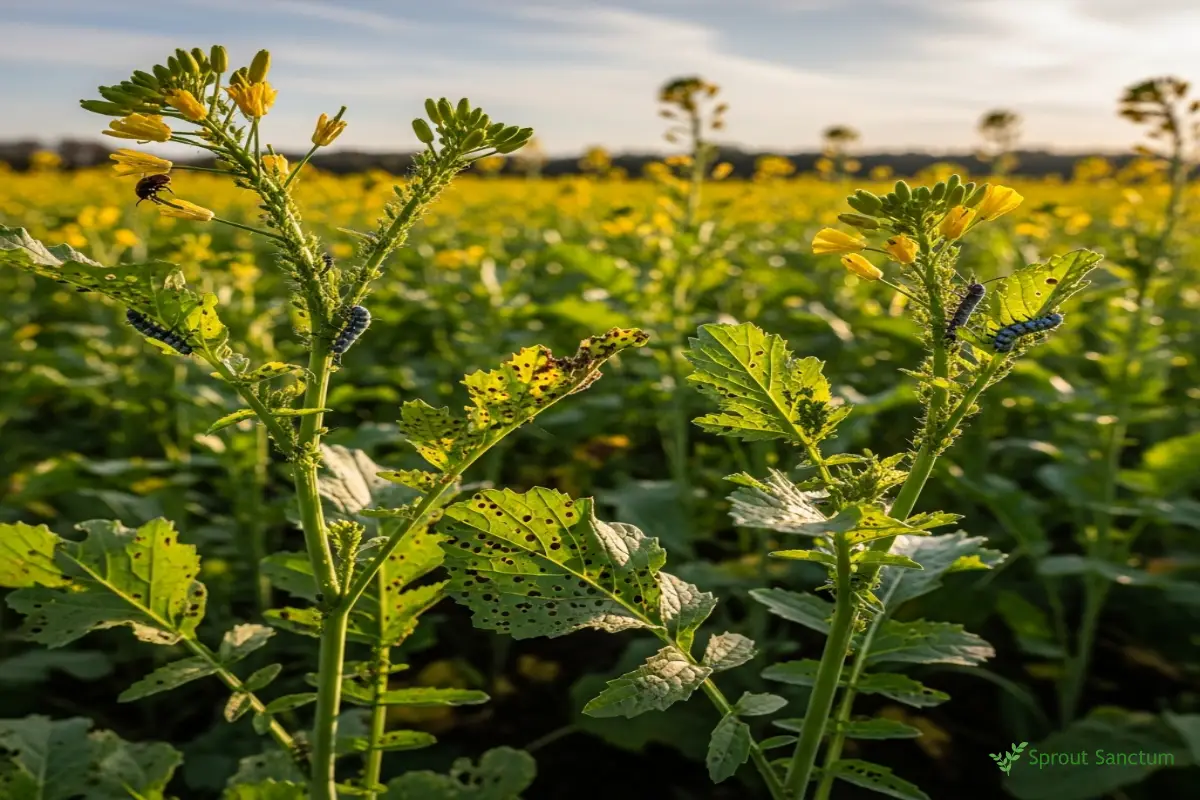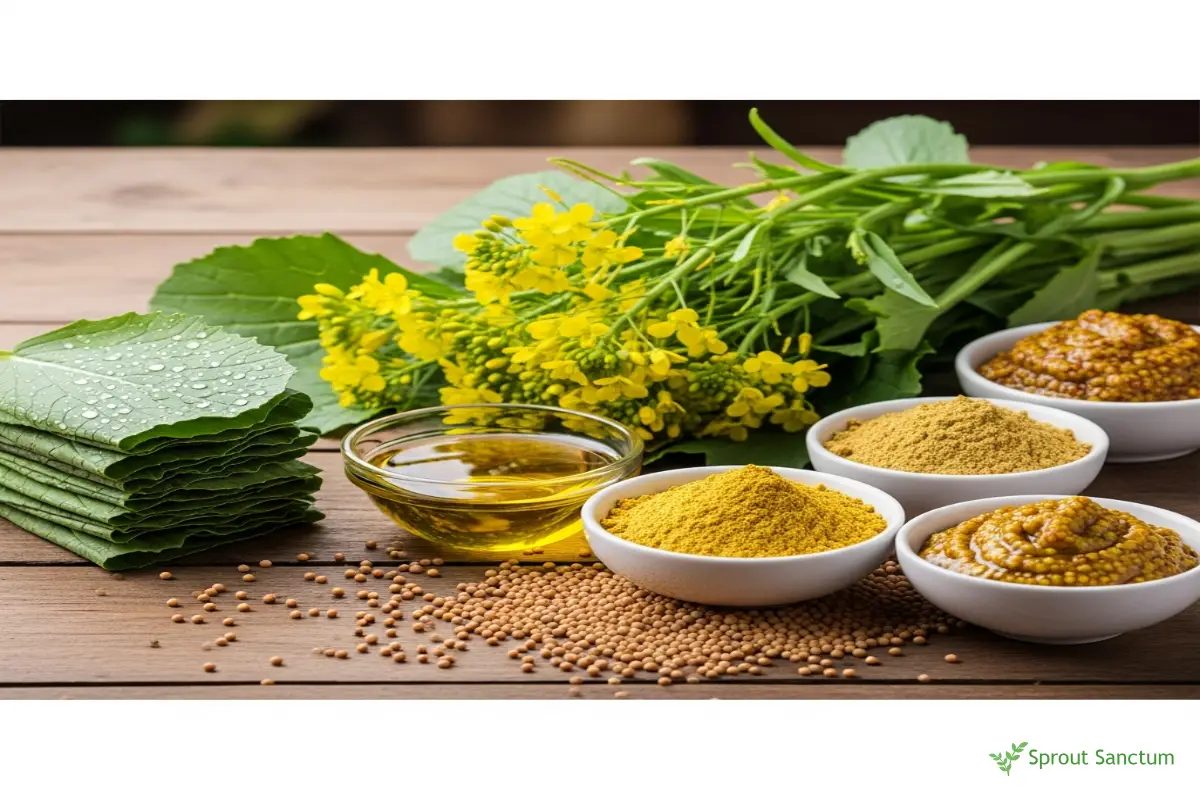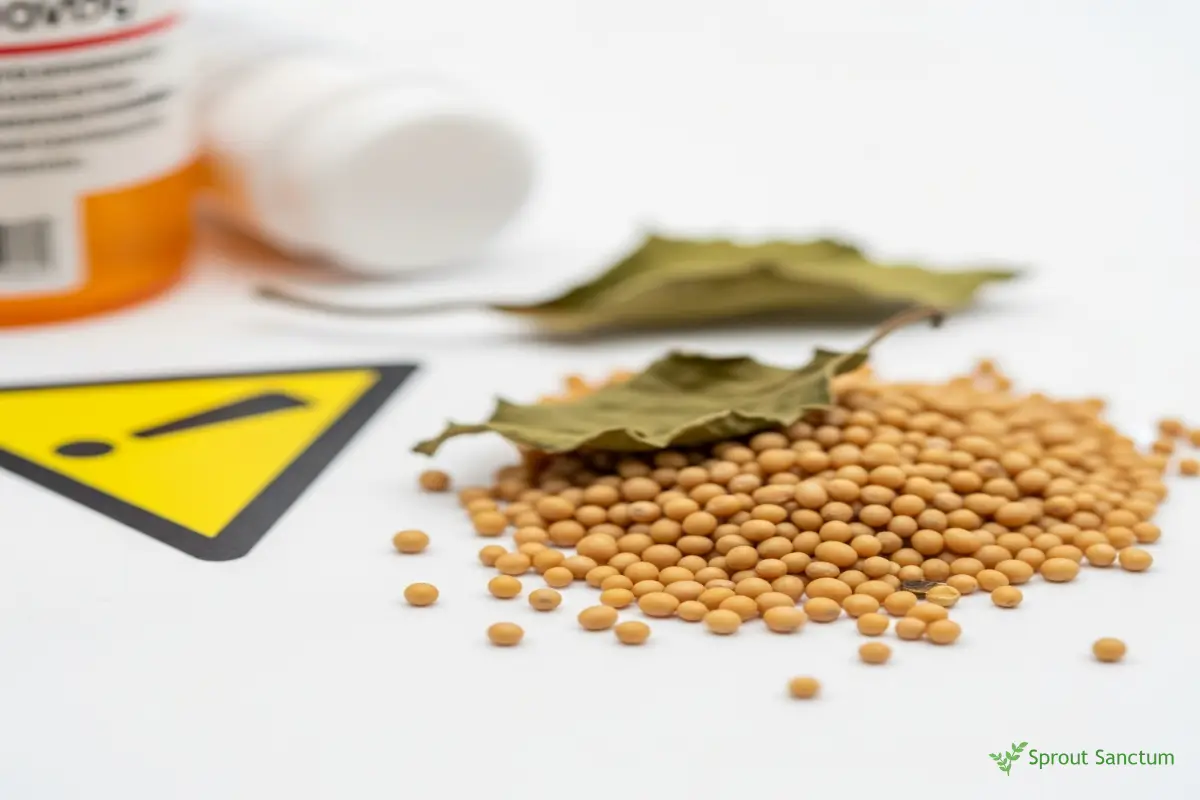Mustard Plants: How to Grow, Care, and Use Them at Home
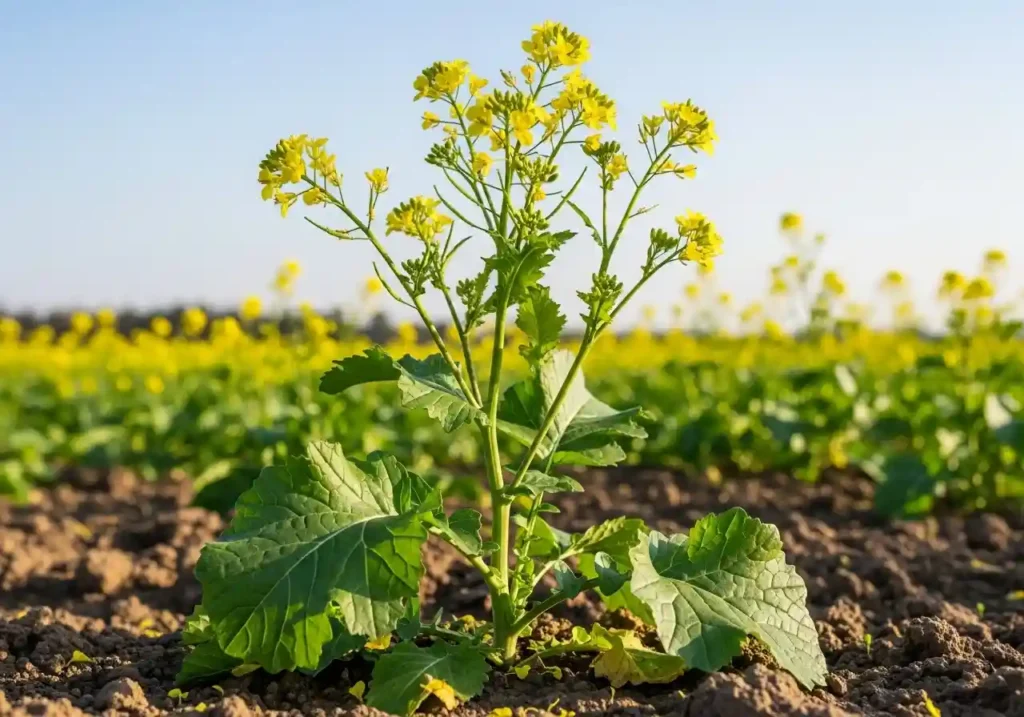
Sep
Mustard is more than a simple condiment but its history is less discussed. This mustard herbaceous annual is relatively easy to grow while its seeds and greens are also nutritious. Its cultivation has culinary, agricultural, and medicinal importance. Ancient civilizations as well as modern farmers have used the mustard plant and its adaptability is truly impressive.
It is a valued plant as its protein, dietary fiber, and vitamins. Not to mention omega 3. It also has minerals like calcium, iron and selenium. This is a comprehensive guide to outline the plant to a plant enthusiast. It will cover the different types of mustard, growing techniques, and lastly its roots and modern uses.
Types of Mustard Plants
Galloping through the bounds of diverse mustard species is both artful and enlightening. Each species is imbued with vibrant distinction along with individual merits. It is important to grasp and embrace these differences to revel in the myriad ways mustard can be employed.
Yellow Mustard (Sinapis alba / Brassica hirta)
Yellow mustard is perhaps the most widely accepted common mustard and is the most mild. Its seeds are lower in oil content which is ideal for the mild table mustards most people are warm to. These mustard seeds are common ingredients in mayonnaise, salad dressings, and to be used as an emulsifier in processed meats. Commonly, the plant exhibits a yellow seed coat, with hairy stems and leaves, as well as minute, yellow flowers. From the stand of agriculture, yellow mustard has the unique and unquestionable benefit of being “weevil resistant” when compared to other types of Brassica crops and their susceptibility to cabbage seedpod weevils.
Brown Mustard (Brassica juncea)
Brown mustard is more pungent and spicier than yellow mustard. Brown is the most used for “hot” table mustards like dijon. It is also used for the production of spiced oils. The seeds of the plant are reddish brown to dark brown. This plant is fuzzy on its first leaves and then pale green on its adult leaves. Unlike yellow mustard which is more common. Brown yellow mustards are slabs of useless for the cabbage seedpod weevils.
Oriental Mustard (Brassica juncea)
Oriental Mustard is a type of brown mustard cultivated and used in several Asian countries. Most of the brown mustard is used to make spicy oven oil and other types of sauces. The seeds range in color from yellow to dark yellow. Similarly to other varieties of Brassica juncea, Oriental mustard is also vulnerable to cabbage seedpod weevils.
Black Mustard (Sinapis nigra)
When considering the historical significance of Black Mustard and its intensely sharp, almost radish-likeness flavor, it is one of the major cultural components in Indian and African cooking. Black Mustard produces very very small, black to reddish-black seeds. Also, the growing of black mustard in North America is decreasing because it is difficult to cite (with any satisfaction) the mechanical harvest of Black Mustard compared to the yellow and the brown.
Wild Mustard (Sinapis arvensis)
Wild mustard (Brassica kaber) is a species that is common and considered to be a weed. It has very small black seeds. It is an edible herb, and you will not find it sold commercially, but it is located in fields and growing everywhere along roadsides.
Distinguishing Mustard from Canola
Correctly identifying plants is critical in many gardening situations. Mustards and canola (often canola Brassica napus or Brassica rapa oilseed types) are both Brassicas but they can be easily distinguished based on the plants’ visual characteristics. Mustard plants usually have much hairier stems and leaves, especially in early growth when the plants are very small. Mustard flowers are usually a smaller flower size and deeper yellow than canola flowers, which may also be paler. However, the best differences are within seed and pod. There are often appear to be heavier pod structures with mustard, which are less likely to shatter than many canola varieties and are larger in general. Mustard seeds also vary more in color depending on the type. For example, black, brown and white mustard seeds all have different colors, while many canola varieties are genetically modified by most producers for herbicide tolerance. This means that mustard has remained largely non-GMO and is something many home gardeners wish to avoid.
Cultivation Guide for Home Gardeners
Growing the mighty mustard plant can be an enjoyable activity for the home gardener. Its flexibility and relatively little care requirements make it a great addition to your garden to provide spice and nutrition.
Climate and Soil Requirements
Mustard is mainly a cool season crop, so its tolerance to light frost allows for initial spring planting or late fall planting. It grows well in well-drained loamy soils, which prefer a pH of 6.0 to 7.5. Although it shows good drought tolerance after establishment, it is very susceptible to water logging, which will quickly cause root disease and a lowered yield.
Land Preparation
Proper preparation of the land is critical to the successful establishment of mustard. The soil should be plowed or tilled to a depth of about six inches (15 cm) in order to provide good aeration and root penetration. The next step is to level off the surface of the soil and preferably create a firm and moist seedbed. This is necessary to promote uniform germination of the seeds. If you are using no-till gardening, manage the residue from the previous crop properly so as to minimize disease and pest problems and create good seed-to-soil contact.
Planting (Sowing)
- Timing: For optimal seed yield, planting should occur in early spring, as soon as the soil can be worked. Alternatively, mustard can be direct-sown in the fall for an earlier spring crop, or as a cover crop.
- Depth: Seeds should be planted at a depth of 0.5 to 1 inch (1.25-2.5 cm). In drier soil conditions, planting slightly deeper, up to 2 inches (5 cm), can help seeds access moisture.
- Spacing: When planting for seed production, space individual seeds 2-3 inches (5-7.5 cm) apart within rows, with rows spaced 12-18 inches (30-45 cm) apart. For mustard greens, seeds can be sown more densely, and then thinned.
- Seeding Rate: For larger areas, yellow mustard typically requires a seeding rate of 7-10 lbs per acre (7.8-11.2 kg/hectare), while brown and oriental mustards, having smaller seeds, require 4-6 lbs per acre (4.5-6.7 kg/hectare).
Care (Watering and Fertilization)
- Watering: Regular watering is crucial, especially during the initial weeks after germination and during flowering and seed development. Consistent moisture helps in establishing strong plants and ensures good seed fill. While drought-tolerant, prolonged dry spells will reduce yield.
- Fertilization: Mustard benefits from a balanced fertilizer application every 2-4 weeks, particularly if your soil is low in nutrients. A soil test is highly recommended to determine specific nutrient deficiencies. Mustard plants require adequate levels of Nitrogen (N) for vegetative growth, Phosphorus (P) for root development and flowering, Potassium (K) for overall plant health, and Sulfur (S) for glucosinolate formation (which contributes to its pungency). Be cautious with seed-placed nitrogen, as mustard seedlings can be sensitive to it.
Pest and disease management in mustard plants
Effective pest and disease management is vital for a healthy mustard crop.
- Common Pests:
- Flea Beetles: Small, jumping beetles that chew small holes in leaves, especially on seedlings.
- Cutworms: Larvae that sever young plants at the soil line.
- Diamondback Moths: Larvae feed on leaves, leaving “windowpane” damage.
- Bertha Armyworms: Caterpillars that defoliate plants and feed on pods.
- Cabbage Seedpod Weevils: Larvae feed inside seed pods, reducing yield. (Note: Yellow mustard shows higher resistance).
- Common Diseases:
- Damping-off: Fungal disease causing seedlings to rot at the soil line.
- Alternaria (Black Spot): Causes dark spots on leaves, stems, and pods.
- Aster Yellows: A phytoplasma disease transmitted by leafhoppers, causing yellowing and distorted growth.
- Sclerotinia (White Mold): Fungal disease causing white, cottony growth and stem rot.
- Downy Mildew: Appears as fuzzy white patches on the underside of leaves.
- White Rust: Causes white, blister-like pustules on leaves and stems.
Blackleg: A serious fungal disease (Note: Brassica juncea* varieties, including brown and oriental mustards, exhibit some resistance).
- Clubroot: A soil-borne disease causing distorted, club-like roots.
- Management Strategies: Implement good agronomic practices such as crop rotation (avoiding planting Brassicas in the same spot for at least 3-4 years), using certified disease-free seeds, and ensuring proper sanitation. Seed treatments (commercially available for some pests and diseases) can protect young seedlings. If pest or disease pressure is severe, registered foliar sprays may be necessary; always consult local agricultural extension services for recommended products and adhere strictly to application guidelines and pre-harvest intervals (MRLs) for home garden use.
Harvesting and Storage
- Harvesting: Mustard plants are typically ready for harvest when the pods (siliques) turn yellow and the seeds inside are plump and have begun to change color. For greens, leaves can be picked throughout the growing season. For seeds, the entire plant is usually cut at the base before the pods fully dry and become prone to shattering. The plants are then typically allowed to dry further in a protected area before threshing to separate the seeds. Yellow mustard varieties generally exhibit higher shatter tolerance, making harvesting easier. Optimal seed moisture content for combining is around 9%.
- Storage: Store cleaned and dried mustard seeds in a cool, dry place with good ventilation, ideally at 9% moisture content or less, for long-term preservation. Monitoring for moisture accumulation and potential spoilage is crucial. Properly stored seeds can last for several years.
The Versatile Uses of Mustard
The mustard plant offers an astounding array of uses, spanning culinary delights, health and wellness applications, and even agricultural benefits.
Culinary Applications
- Seeds: Mustard seeds are the cornerstone of many culinary traditions. They are ground into a vast array of condiments, from mild yellow mustards to pungent Dijon, whole grain, and spicy mustards. In cooking, whole or ground seeds are used as a spice, particularly prominent in Indian cuisine where they are often tempered in hot oil to release their flavor before other ingredients are added. They also serve as flavorings for pickles, baked goods, and various sauces.
- Oil: Oriental mustard varieties are specifically cultivated for their seeds, which are pressed to extract a spicy cooking oil widely used in many Asian kitchens, imparting a distinctive flavor to dishes.
- Leaves: The tender young leaves of the mustard plant, known as mustard greens, are a highly nutritious and flavorful vegetable. They can be eaten raw in salads or cooked like spinach or collard greens. They are a rich source of calcium, iron, and a plethora of vitamins, making them a healthy addition to any diet.
Health and Wellness Benefits of Mustard Plant
The nutritional density of the mustard plant positions it as a significant contributor to health and wellness.
- Nutritional Powerhouse: As previously mentioned, mustard is packed with protein, fiber, vitamins (C, E, B-complex), Omega-3 fatty acids, and essential minerals like calcium, iron, magnesium, and selenium.
- Antioxidant Rich: Mustard contains a wealth of antioxidant compounds, including phenolic compounds, Vitamin E, carotenoids, and most notably, glucosinolates. When mustard plant cells are crushed, glucosinolates are hydrolyzed into isothiocyanates (like sinigrin), which are potent antioxidants and bioactive compounds. These compounds help combat free radical damage in the body, which is linked to aging and various chronic diseases.
- Potential Health Impacts: Numerous studies have explored the potential health benefits associated with mustard consumption. These include:
- Cardiovascular Health: Some compounds may contribute to reducing the risk of heart disease by lowering cholesterol and blood pressure.
- Blood Sugar Regulation: Research suggests a potential role in managing type 2 diabetes by improving insulin sensitivity.
- Cancer Prevention: The glucosinolates and isothiocyanates are extensively studied for their chemopreventive properties against certain types of cancers.
- Anti-inflammatory Properties: Certain constituents of mustard may help alleviate inflammation throughout the body.
- Pain Relief: Traditionally, mustard plasters have been used topically to relieve muscle pain and congestion.
- Skin and Hair Health: The oils and nutrients are sometimes incorporated into natural remedies for skin and hair care.
- Cold Symptoms: Inhalation of mustard vapor or consumption of mustard preparations is sometimes used to alleviate cold and cough symptoms due to its warming and decongestant properties.
- Important Disclaimer: While mustard offers many potential health benefits, it is crucial to understand that these claims are often based on scientific studies that may not directly translate to medical treatment. Always consult a healthcare professional before using mustard or any other food for medicinal purposes, especially if you have pre-existing health conditions or are taking medication.
Agricultural Uses
Beyond its direct human consumption, mustard plays a vital role in sustainable agriculture.
- Cover Crop and Biofumigant: Mustard varieties, particularly those rich in glucosinolates, are increasingly used as cover crops. When incorporated into the soil, the breakdown products of these glucosinolates act as natural biofumigants. These compounds can suppress soil-borne pests, nematodes, and weeds, offering an environmentally friendly alternative to synthetic pesticides. They also improve soil structure, add organic matter, and prevent erosion.
Historical Significance of Mustard Plant
The mustard plant has an extraordinarily long history, having been part of human civilization for thousands of years. Its evolution from a wild plant to a global entity tells us that it was very valuable long before we started using it.
The history of mustard comes from the earliest times, and many historians report that it has been formally documented as early as 9000 BCE in Syria. In addition to being mentioned in church literature, it is also depicted and referred to in ancient Greek and Roman historical accounts, as well as in Buddhist, Taoist, and other ancient texts. It is safe to say that it was well known and understood by people in these early societies.
During the Medieval period in Europe, mustard became one of the most ubiquitous and well-known spices available to the general population. Mustard was not an exotic spice that needed to be imported from far-off lands at great expense. Mustard was easy to grow locally; therefore, it could be available to everyone as a means of enhancing flavors. Mustard was often mixed with vinegar or grape must as part of a simple sauce and was often used in baking. Some people even valued mustard as folk medicine or for its medicinal properties. The monks were one of the groups responsible for growing and spreading mustard throughout the continent, especially in France.
The Romans also developed what we now now as mustard in the form of a sauce and enjoyed it as everyday fare for working class and wealthy households alike and in many instances it was used with greasy meats so it’s hitting flavor complimented richness of the meat and aided in digestion. This condiment for meat must have been so important as the Roman writer Columella offered an elaborate discussion of making a mustard condiment, suggesting it was commonplace.
The most notable period of mustard’s modern development came during the disruption of trade during WWII triggered increases in mustard production and consumption in North America. This phase of development further established mustard as a world condiment along the way to developing all the packaged prepared mustards we have today.
Potential Disadvantages and Precautions of Mustard Plant
While the mustard plant offers numerous benefits, it is important to be aware of potential downsides and take necessary precautions.
- Allergies: Mustard is a recognized allergen. Symptoms of mustard allergy can range from mild (skin rash, itching, hives, digestive upset like nausea, vomiting, or diarrhea) to severe (swelling of the face or throat, difficulty breathing, dizziness, or, rarely, anaphylaxis, a life-threatening allergic reaction). Individuals with known allergies to other Brassica family members may also be sensitive to mustard.
- Overconsumption: While generally safe in culinary amounts, consuming very large quantities of mustard, particularly black mustard seeds, can lead to potential side effects. These may include gastrointestinal distress, diarrhea, drowsiness, breathing issues, and in extreme cases, coma. This is typically only a concern with medicinal or excessive consumption, not normal dietary intake.
- Pregnancy: Pregnant women are generally advised to avoid consuming large quantities of white and black mustard, especially in medicinal forms, due to the risk of stimulating uterine contractions. Culinary amounts are usually considered safe, but caution is recommended.
- Thyroid Function: Uncooked mustard leaves and seeds, like other cruciferous vegetables, contain goitrogens, compounds that can potentially interfere with thyroid function if consumed in very large raw quantities by individuals with pre-existing thyroid conditions. Cooking usually deactivates these compounds.
- General Advice: Always exercise caution and moderation. If you experience any adverse reactions after consuming mustard, discontinue use and consult a healthcare professional. It is always best to consult a doctor or qualified health practitioner before using mustard or any other plant-based product for medicinal purposes, especially if you have underlying health conditions, are pregnant, or are taking medications.
Conclusion
More than just a condiment, the mustard plant is an example of nature’s true abundance. The mustard plant is easy to grow, has various types, and has a high nutritional value, and is worthy of addition to anyone’s garden or kitchen. The mustard plant has evolved from being a staple food and medicine in ancient times to its modern applications used as a versatile spice, healthy food, and now an agricultural biofumigant, mustard’s role is continuing to evolve. For home gardeners looking for a profitable, nutrient-dense, and highly versatile plant, growing mustard will not only benefit our stomachs, but will also extend our awareness of a plant rich with history and full of possibilities!
Ready to explore more incredible plants for your garden or learn about their fascinating benefits? Dive deeper into the world of flora with us! Visit sprout sanctum for more guides, tips, and inspiration for every plant enthusiast!
Frequently Asked Questions (FAQ)
When to plant mustard greens?
Mustard greens are considered cool-season crops. You can plant seeds in early spring for a spring harvest, or you can plant seeds in late summer to early fall for a harvest of fall and winter greens. In warmer climates (like Zone 7, Louisiana, Texas and Georgia), you may often overlook the chance to plant them (and many other greens) in late summer through fall for your winter greens.
How to plant mustard?
Sow mustard seeds 0.5 to 1 inch deep, 2-3 inches apart in rows spaced 12-18 inches apart. Ensure a firm, moist seedbed and water regularly after planting, especially during germination.
What does a mustard plant look like?
Mustard plants are herbaceous annuals. They typically have green, often hairy leaves that can be lobed or toothed, bright yellow flowers with four petals, and thin seed pods (siliques) that form after flowering.
How big is a mustard plant?
Mustard plants vary in size depending on the type and growing conditions. They typically grow from 2 to 6 feet tall, though some varieties, especially for seed production, can reach up to 8 feet.
How to take care of mustard plant?
Provide well-drained loamy soil, consistent moisture, especially during growth and flowering, and a balanced fertilizer every 2-4 weeks after a soil test. Monitor for pests and diseases, and practice crop rotation.
What part of mustard plant is edible?
All parts of the mustard plant are edible: the leaves (mustard greens), stems, flowers, and seeds. The roots are generally not consumed but are not toxic.
Is mustard plant invasive?
While some wild mustard species can be aggressive self-seeders and considered weeds in agricultural fields, cultivated mustard varieties are generally not considered invasive in a typical garden setting if managed properly.
Is mustard plant edible?
Yes, the entire mustard plant is edible. Its leaves are consumed as greens, its flowers are edible, and its seeds are used for spices, oil, and condiments.
What plants are in the mustard family?
Mustard belongs to the Brassicaceae family (also known as Cruciferae). This large family includes many common vegetables like cabbage, broccoli, cauliflower, kale, radishes, turnips, and brussels sprouts.
Can you plant mustard seeds?
Yes, you can plant mustard seeds. They are readily available from garden supply stores and will sprout and grow into mustard plants given the right conditions.
Which part of mustard plant is edible?
The leaves, stems, flowers, and seeds of the mustard plant are all edible. The leaves are eaten as greens, and the seeds are used for spices and oil.
Can you plant mustard seeds from the grocery store?
Yes, you can often plant whole mustard seeds purchased from the grocery store, particularly if they are fresh and not treated. However, germination rates may be lower than those of specially packaged garden seeds.
When to plant mustard seeds?
Plant mustard seeds in early spring as soon as the soil can be worked for a full yield, or in late summer to early fall for a fall/winter harvest, especially for greens.
When to plant mustard cover crop?
Mustard is typically planted as a cover crop in late summer or early fall after a main harvest, to grow through the fall and sometimes into early winter before being tilled into the soil.
How to draw mustard plant?
To draw a mustard plant, sketch an upright stem, then add lobed or toothed leaves originating from the stem. Near the top, draw clusters of small, four-petaled yellow flowers, followed by slender seed pods (siliques).
Is mustard a perennial?
No, mustard is an annual plant, meaning it completes its life cycle within one growing season and then dies. It is not perennial.
Is mustard plant toxic to dogs/cats/horses?
Mustard seeds, plants, and prepared mustards contain compounds that can be irritating or mildly toxic to pets if consumed in large quantities, potentially causing gastrointestinal upset. It’s best to avoid feeding them to animals.
Are mustard plants weeds?
Some species of mustard, particularly wild mustard (Sinapis arvensis), are considered weeds in agricultural fields due to their ability to compete with cultivated crops. However, cultivated mustard varieties are grown intentionally.
Are mustard plants poisonous/toxic/invasive?
Cultivated mustard plants are not considered poisonous or toxic in typical culinary amounts. Some wild varieties can be weedy but are generally not considered truly invasive in ecological terms. Excessive consumption of black mustard seeds can be toxic.
Are mustard plants yellow?
The flowers of most common mustard plants are bright yellow. The seed coats can range from yellow to brown or black.
Does mustard plant have flowers/yellow flowers?
Yes, mustard plants produce small, typically bright yellow flowers, arranged in clusters, which later develop into seed pods.
Does mustard plant grow into trees?
No, mustard plants are herbaceous annuals and do not grow into trees. They are typically bushy plants that can reach several feet in height but remain non-woody.
How deep should mustard seeds be planted?
Mustard seeds should be planted at a depth of 0.5 to 1 inch (1.25-2.5 cm). In very dry conditions, planting slightly deeper, up to 2 inches (5 cm), can be beneficial.
How far apart should mustard greens be planted?
For mustard greens, seeds can be sown densely and then thinned to 4-6 inches apart. For larger plants or seed production, space them 6-8 inches apart.
How often should I water mustard plant?
Water regularly, especially during germination, establishment, and flowering. The soil should remain consistently moist but not waterlogged. Depending on climate, this could be every few days.
Is mustard good for plants?
Mustard can be good for plants when used as a cover crop, as it improves soil structure, adds organic matter, and acts as a biofumigant to suppress pests and weeds.
Why are wheat and mustard plants classified as angiosperms?
Both wheat and mustard are classified as angiosperms because they are flowering plants that produce seeds enclosed within an ovary (which develops into a fruit).
Is there a mustard plant?
Yes, there are several species of mustard plants, widely cultivated for their seeds, leaves, and oil.
What is the scientific name of mustard plant?
Common scientific names for cultivated mustard include Sinapis alba (yellow/white mustard) and Brassica juncea (brown/oriental mustard). Sinapis nigra is black mustard.
Does mustard plant have tap root/fibrous root/reticulate venation?
Mustard plants generally have a taproot system. Their leaves exhibit reticulate venation, meaning a network of veins branches out from a central midrib.
What kind of fruits does a mustard plant have?
The “fruit” of a mustard plant is a type of pod called a silique, which is long and slender and contains the seeds.
Will mustard seeds grow/sprout?
Yes, viable mustard seeds will sprout and grow into plants if provided with suitable conditions (moisture, warmth, light).
Will mustard greens grow back?
Yes, if harvested correctly by taking only the outer leaves, mustard greens can often grow back, providing multiple harvests from the same plant.
What happens if you plant a mustard seed?
If you plant a viable mustard seed in suitable conditions, it will germinate, grow into a seedling, then a mature plant, produce flowers, and eventually develop seed pods containing new seeds.
Why is mustard classified as dicot plant?
Mustard is classified as a dicot (dicotyledonous) plant because its seeds have two cotyledons (embryonic leaves), its flowers typically have parts in multiples of four or five, and its leaves have reticulate venation.
Why plant mustard seeds/why plant mustard?
People plant mustard for various reasons: to harvest the leaves as greens, to collect the seeds for spices or oil, as a beneficial cover crop, or for its biofumigant properties in the garden.
Will mustard plants smell or smell like mustard/taste like mustard?
Yes, mustard plants, especially when crushed or cooked, release volatile compounds that give them a distinctive pungent, peppery, or “mustard” smell and taste.
Who planted the mustard seed (fun/historical)?
The “mustard seed” is famously mentioned in a parable by Jesus in the New Testament, illustrating faith and the growth of the Kingdom of Heaven from humble beginnings. Historically, various ancient peoples cultivated it.
What kind of mustard plant was Jesus talking about?
Scholars believe Jesus was likely referring to Sinapis nigra (Black Mustard) or a closely related wild mustard species common in the Middle East, which was known for its small seeds growing into surprisingly large bushes.
How to make mustard from mustard plant?
To make prepared mustard, harvest and dry the seeds, then grind them into a powder. Mix the powder with liquids like vinegar or water, salt, and other spices to create a paste or sauce.
Why did Mendel not select mustard plant?
Gregor Mendel primarily chose the pea plant (Pisum sativum) for his genetic experiments due to its clear, easily distinguishable traits, self-pollinating nature, and short generation time, which made it ideal for studying inheritance patterns. Mustard plants might have presented more complex trait expressions or growth habits for his specific research questions.
Which mustard plant is best for health?
All edible mustard varieties offer significant nutritional benefits. Brown and black mustards tend to have higher levels of glucosinolates, which are linked to various health benefits. Mustard greens are particularly rich in vitamins and minerals.
Does mustard plant make mustard?
Yes, the seeds of the mustard plant are the raw material from which prepared mustard (the condiment) is made. The leaves are eaten as mustard greens.
Do mustard plants fix nitrogen?
No, mustard plants are not legumes and do not fix atmospheric nitrogen. They are Brassicas, and while they improve soil health, they do not have nitrogen-fixing capabilities.
Will deer eat mustard plants?
Deer may browse on mustard plants, especially the tender young leaves, particularly if other preferred food sources are scarce. However, their pungent flavor can sometimes deter deer.

